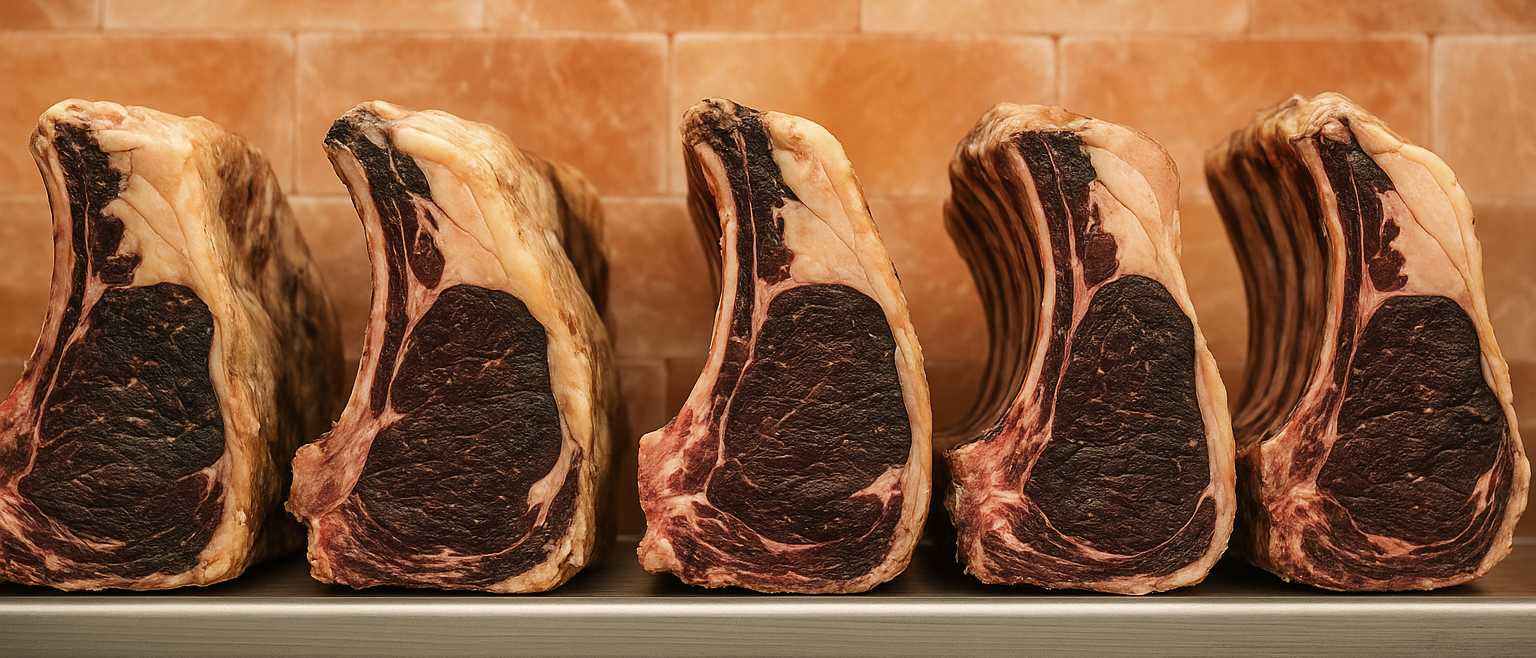
We believe flavour starts in the field. Native breeds like Shorthorn, Dexter, and traditional Wagyu crosses bring something distinct to the table — not just in marbling or tenderness, but in depth, texture, and integrity. These animals graze varied pastures, live slow-growing lives, and are shaped by the land. Their stories matter.
We’re drawn to beef with a sense of place — beef that doesn’t just taste good, but tastes of somewhere. The richness of a Ribeye or the mineral tang of a dry-aged Rump can’t be faked or rushed. It begins in the way an animal lives.
Respect continues through the final steps. A calm end, close to home, is better for the animal — and better for the meat. Once slaughtered, beef needs time. Hanging allows it to become itself.
We believe in giving beef that time — to soften, concentrate, deepen. Twenty-eight days, sometimes more. The muscles relax, the fibres begin to yield, and something more complex emerges. That’s when beef becomes memorable.
This stage is where the texture changes. The meat firms up while losing moisture, developing a denser bite. Aromas develop. A good butcher will tell you: hanging beef is about patience, not precision.
Every cut has a natural shape. We think butchery should follow it. Seam butchery — that old-fashioned, muscle-by-muscle method — respects the way the animal was built. It makes better joints. It wastes less. It honours the craft.
You end up with more than just nice steaks. You get featherblade with its delicate grain, flat iron with its surprising tenderness, cheek and shin with structure and soul. Bones are kept when they matter, removed when they don’t. Every piece is cut with a cook’s eye — not just a scale.
There’s a world of difference between meat that’s been aged in plastic and meat that’s had time to breathe. We believe dry ageing is more than tradition — it’s transformation. Moisture evaporates. Flavour deepens. The meat develops a quiet confidence.
Unlike wet-aged beef, which can be soft but bland, dry-aged beef has texture and integrity. The edges darken, the flavour concentrates. It’s not just a matter of days — it’s about judgement. Knowing when a cut has peaked. Knowing how long to wait.
Good dry-aged beef doesn’t shout. It’s nutty, savoury, sometimes almost blue-cheesy. It’s not for everyone — but if you love beef, you’ll notice.
We believe in fat. Not too much, not too little — the right kind in the right place. Fat that melts and bastes, that caramelises and crisps, that brings flavour where it’s needed most.
There’s a difference between a line of fat and a smear of gristle. Good beef fat is creamy, not waxy; golden, not grey. It carries flavour, holds moisture, and gives you that unctuous finish.
Marbling isn’t about show. It’s about texture, balance, and how beef behaves in the pan. Richer doesn’t always mean better — but better usually means well-fed, well-aged, and well-cut.
Beef that’s been well bred, well handled, and well-aged doesn’t ask for much. Just salt, heat, and time. It doesn’t need to be hidden under sauces. It doesn’t need tricks. It just needs to be cooked like it matters.
It might cook faster. It might brown more deeply. It might even surprise you with how little it needs. Don’t overthink it — just bring the heat, rest it well, and let it speak for itself.
That’s what we believe. And we think, once you’ve tasted the difference, you might believe it too.